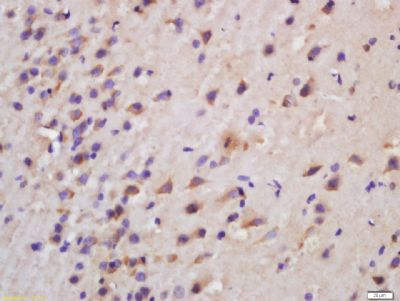Ceramide synthase 1 Polyclonal Antibody
Purified Rabbit Polyclonal Antibody (Pab)
- SPECIFICATION
- CITATIONS
- PROTOCOLS
- BACKGROUND

Application
| WB, IHC-P, IHC-F, IF, E |
|---|---|
| Primary Accession | P27544 |
| Reactivity | Rat, Pig, Dog, Bovine |
| Host | Rabbit |
| Clonality | Polyclonal |
| Calculated MW | 39 KDa |
| Physical State | Liquid |
| Immunogen | KLH conjugated synthetic peptide derived from human LASS1 |
| Epitope Specificity | 181-280/350 |
| Isotype | IgG |
| Purity | affinity purified by Protein A |
| Buffer | 0.01M TBS (pH7.4) with 1% BSA, 0.02% Proclin300 and 50% Glycerol. |
| SUBCELLULAR LOCATION | Endoplasmic reticulum membrane; Multi-pass membrane protein. Isoform 1: Endoplasmic reticulum membrane; Multi-pass membrane protein. Golgi apparatus membrane; Multi-pass membrane protein. Note=Isoform 1 may recycle from the Golgi to the endoplasmic reticulum. |
| SIMILARITY | Contains 1 TLC (TRAM/LAG1/CLN8) domain. |
| Important Note | This product as supplied is intended for research use only, not for use in human, therapeutic or diagnostic applications. |
| Background Descriptions | LASS1 may be either a bona fide (dihydro)ceramide synthase or a modulator of its activity. When overexpressed in cells it is involved in the production of sphingolipids containing mainly one fatty acid donnor in a fumonisin B1-independent manner. |
| Gene ID | 10715 |
|---|---|
| Other Names | Ceramide synthase 1, CerS1, 2.3.1.-, LAG1 longevity assurance homolog 1, Longevity assurance gene 1 protein homolog 1, Protein UOG-1, CERS1 {ECO:0000303|PubMed:17977534, ECO:0000312|HGNC:HGNC:14253} |
| Dilution | WB=1:500-2000,IHC-P=1:100-500,IHC-F=1:100-500,IF=1:100-500,ELISA=1:5000-10000 |
| Storage | Store at -20 ℃ for one year. Avoid repeated freeze/thaw cycles. When reconstituted in sterile pH 7.4 0.01M PBS or diluent of antibody the antibody is stable for at least two weeks at 2-4 ℃. |
| Name | CERS1 {ECO:0000303|PubMed:17977534, ECO:0000312|HGNC:HGNC:14253} |
|---|---|
| Function | Ceramide synthase that catalyzes the transfer of the acyl chain from acyl-CoA to a sphingoid base, with high selectivity toward stearoyl-CoA (octadecanoyl-CoA; C18:0-CoA) (PubMed:17977534, PubMed:23530041, PubMed:26887952, PubMed:31916624). N-acylates sphinganine and sphingosine bases to form dihydroceramides and ceramides in de novo synthesis and salvage pathways, respectively (PubMed:17977534, PubMed:23530041, PubMed:24782409, PubMed:26887952, PubMed:31916624). Plays a predominant role in skeletal muscle in regulating C18 ceramide and dihydroceramide levels with an impact on whole-body glucose metabolism and insulin sensitivity. Protects from diet-induced obesity by suppressing the uptake of glucose in multiple organs in a FGF21-dependent way (By similarity). Generates C18 ceramides in the brain, playing a critical role in cerebellar development and Purkinje cell function (By similarity). In response to cellular stress mediates mitophagy, a known defense mechanism against cell transformation and aging. Upon mitochondria fission, generates C18 ceramides that anchor lipidated MAP1LC3B/LC3B-II autophagolysosomes to outer mitochondrial membranes to eliminate damaged mitochondria (PubMed:22922758). |
| Cellular Location | Endoplasmic reticulum membrane; Multi-pass membrane protein |

Thousands of laboratories across the world have published research that depended on the performance of antibodies from Abcepta to advance their research. Check out links to articles that cite our products in major peer-reviewed journals, organized by research category.
info@abcepta.com, and receive a free "I Love Antibodies" mug.
Provided below are standard protocols that you may find useful for product applications.
If you have used an Abcepta product and would like to share how it has performed, please click on the "Submit Review" button and provide the requested information. Our staff will examine and post your review and contact you if needed.
If you have any additional inquiries please email technical services at tech@abcepta.com.













 Foundational characteristics of cancer include proliferation, angiogenesis, migration, evasion of apoptosis, and cellular immortality. Find key markers for these cellular processes and antibodies to detect them.
Foundational characteristics of cancer include proliferation, angiogenesis, migration, evasion of apoptosis, and cellular immortality. Find key markers for these cellular processes and antibodies to detect them. The SUMOplot™ Analysis Program predicts and scores sumoylation sites in your protein. SUMOylation is a post-translational modification involved in various cellular processes, such as nuclear-cytosolic transport, transcriptional regulation, apoptosis, protein stability, response to stress, and progression through the cell cycle.
The SUMOplot™ Analysis Program predicts and scores sumoylation sites in your protein. SUMOylation is a post-translational modification involved in various cellular processes, such as nuclear-cytosolic transport, transcriptional regulation, apoptosis, protein stability, response to stress, and progression through the cell cycle. The Autophagy Receptor Motif Plotter predicts and scores autophagy receptor binding sites in your protein. Identifying proteins connected to this pathway is critical to understanding the role of autophagy in physiological as well as pathological processes such as development, differentiation, neurodegenerative diseases, stress, infection, and cancer.
The Autophagy Receptor Motif Plotter predicts and scores autophagy receptor binding sites in your protein. Identifying proteins connected to this pathway is critical to understanding the role of autophagy in physiological as well as pathological processes such as development, differentiation, neurodegenerative diseases, stress, infection, and cancer.


